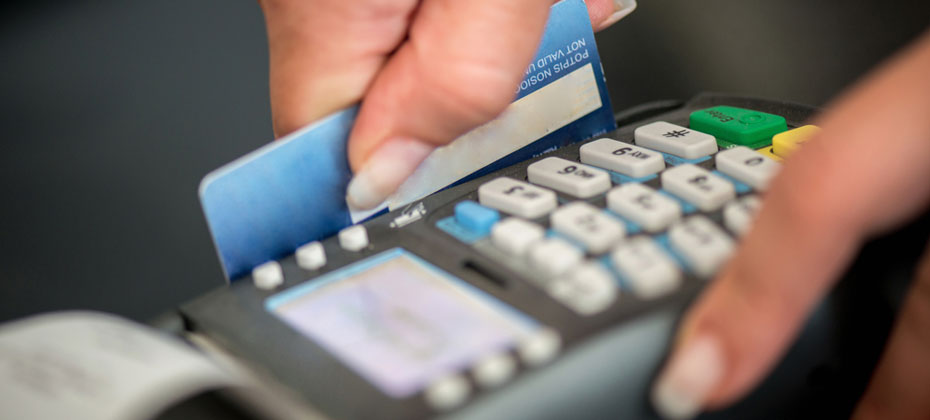Tag: bankcard

The economy remains steady, maintaining a positive outlook even though the GDP growth slowed in the first quarter. Real estate is holding ground even as rates rise. We’ve reached a 7-year high in 30-year fixed-rate mortgages, which could have a longer-term effect on this market. Bankcard may be reaching its limit — outstanding balances hit $764 billion and delinquency rates continue to rise. While auto originations were flat in Q1, performance is improving as focus moves away from subprime lending. The economy remains steady as we transition from 2017. Keep an eye on inflation and interest rates in regard to their possible short-term economic impact. Learn more about these and other economic trends with the on-demand recording of the webinar. Watch now

How do credit unions stack up in a pack filled with heavy-hitting banks and aggressive online lenders? Do credit scores, debt levels and utilization rates look different between credit union members and non-credit union members? Where is the greatest concentration of credit unions in the country? Experian took a deep dive into the data and performance surrounding the credit union universe in their first-ever “State of Credit Unions” report, featuring insights utilizing data from both 2015 and 2017. What did the analysis reveal? “In general, we saw credit unions continuing to increase their auto lending market share, but we also saw them growing their member relationships and increasing market share in mortgage, personal loan and bankcard,” said Michelle Cocchiarella, the Experian analyst who pulled the data. A few of the key data points include: Credit union auto originations increased from 1.54M new accounts in Q1 2015 to 1.93M in Q1 2017 – a 25% increase. And not only did originations rise dramatically in this space, but credit unions topped banks, captives and other finance sources. Credit union auto market share rose 5% between Q1 2015 and Q1 2017, while bank market share declined by 4%. Credit unions also saw growth in the personal loan arena, with market share rising 2% between Q1 2015 and Q1 2017. Still, with the rise of online lenders, that sector saw a 7% increase during the same period. Banks declined by 5%. While most bankcards are opened with banks, credit unions did experience an 18% increase in bankcard originations from Q1 2015 to Q1 2017. Market share rose 1% between Q1 2015 and Q1 2017 for credit unions in the bankcard space. Banks reign with market share at 96%. Credit union mortgage market share rose 7% between Q1 2015 and Q1 2017. Banks declined by 4%. “Collectively, the credit union space is enjoying remarkable membership and loan growth,” said Scott Butterfield, principal of Your Credit Union Partner, a consulting agency to credit union leaders. “However, this bountiful experience is not enjoyed at all credit unions. The financial services environment has never been more competitive. The best credit unions are relentless at investigating a better way to find and serve more members, and as such, are seeing great growth.” For the complete results, including insights on how credit union members with at least one trade compare to non-credit union members, access the report on our credit union insights page.

Consumer credit card debt reached $650 billion in Q3 2015 — the highest level since Q4 2009.

Experian data shows consumers are more confident managing their credit since the recession. The Q3 2015 Experian Market Intelligence Brief was released today featuring data that highlights consumer credit card debt has now reached its highest level since Q4 2009. Credit card debt levels reached $650 billion in Q3 2015, the highest it has been since Q4 2009 when it was $667 billion. Credit card delinquency rates on outstanding balances 60 or more days past due have decreased 71 percent during the same time period. Combining those indicators with the national unemployment rate dropping 50 percent during the same span illustrates a positive economic outlook on credit card trends among lenders and consumers. “Overall credit card limits have increased 102 percent since Q4 2009 with $82 billion originated in Q3 2015,” said Kelly Kent, vice president of Experian Decision Analytics. “The increase in limits from lenders and the steady climb in credit card debt combined with exceptional delinquency rates signals greater confidence among consumers as they are showing more assurance in managing their credit since the recession. We expect to see credit card debt increase in Q4 based on historical seasonal trends driven by the holiday shopping season especially with the early positive holiday sales as a sign.” The Q3 2015 Experian Market Intelligence Brief report is now available.

This month, it’s all about parties and gift giving and holiday traditions. Fast forward a month, however, and consumers will be in a different place. Today, they are spending. In a few weeks, the focus will be on paying down bills, or perhaps seeking solutions to consolidate or transfer balances. The good news for the economy is consumers are expected to spend more this holiday season – $830 on average, a huge jump from last year’s $720. Total retail is expected to increase 5.6 percent, while ecommerce (thanks Amazon Prime) should rise 13.9 percent. Credit card originations are also trending up more than 1 percent year-over-year as of the end of the third quarter of 2015. So what does this mean for lenders? Card utilization is peaking, creating the perfect scenario for many consumers to seek balance transfers, consolidate debt and search for competitive rates, especially if they’ve been leveraging high-interest cards. A recent analysis by NerdWallet revealed consumers are more interested in shopping with store credit cards than with traditional cards this season, putting them at particular risk of sky-high rates. A deeper look at utilization revealed super-prime consumers use less than 6 percent of their available credit limits, while consumers in the deep-subprime tier use nearly every dollar allotted. “Consumers spend billions during the holidays on high-interest credit cards,” said Kyle Matthies, Experian product manager. “Many of them have excellent credit, but struggle juggling multiple payments, which can lead to delinquencies. Credit card consolidation can provide relief by lowering interest rates and simplifying repayment.” Card issuers that remain passive during this window may find their portfolios at-risk as customers take advantage of seasonal offers. Competitors who capitalize on this peak season of balance transfers will likely be mailing out offers to acquire and grow their card portfolio, as well as protect their current card base. “As banks and credit unions finish out the calendar year, they might seek one last marketing push, so a balance-transfer campaign might be the ideal play,” said Matthies. “Still, to avoid blowing the budget, it helps to leverage data to know exactly who to target – both within and outside the card portfolio.” Specific models and/or tools can identify who to try to retain, as well as provide insights on whom to conquest from the outside. An index can additionally offer guidance on when to lower APRs, sweeten rewards and increase credit limits for specific consumers. The post-holiday balance-transfer wave is coming. The question is which lenders will be best prepared to protect and grow their respective card portfolios.

Using bankcard utilization to forecast holiday spend It’s officially November, and like me, you’ve probably noticed all the holiday promotions in your mailbox and inbox. With only a brief window of holiday shopping available, it’s a retailer’s race to get consumer discretionary dollars. As we near the end of 2015, the U.S. economy continues to improve steadily, and consumers are cautiously optimistic about their financial well-being. National unemployment[i] is down to 5.1 percent, and while the Consumer Confidence Index®[ii] slipped to 97.6 in October, it is still higher than it was at the end of 2014. So will the U.S. consumer spend more this holiday season? One way to measure this behavior is through bankcard utilization rates — i.e., how much of their available credit consumers use. Overall, average bankcard utilization didn’t show much movement in Q3 2015, averaging 20.6 percent, compared with 20.3 percent the year before (a 1.5 percent increase).[iii] However, when we look at utilization rates by VantageScore® credit score tier, we see not only varying year-over-year (YOY) changes among consumer risk segments, but, more importantly, significant disparity in the overall usage of available credit. Q3 2014 Q3 2015 YOY increase Super Prime (781-850) 5.5% 5.6% 1.8% Prime (661-780) 27.4% 27.8% 1.4% Near Prime (601-660 63.8% 64.5% 1.2% Subprime (501-600) 76.1% 78.4% 3.1% Deep Subprime (300-500) 94.7% 97.6% 3.1% Super-prime consumers use less than 6 percent of their available credit limits, while consumers in the deep-subprime tier use nearly every dollar allotted. So while we can’t yet determine how “black” this holiday season will be, we can predict that the lower a consumer’s credit tier, the more that consumer will rely on bankcards to fund his or her holiday shopping. For more credit and market insights, join Robert Stone and I for a Webinar, Unique insights on consumer credit trends and outlook for the remainder of 2015. [i]Bureau of Labor Statistics [ii]The Conference Board [iii]Experian IntelliView℠ VantageScore® is a registered trademark of VantageScore Solutions, LLC.
According to a recent Experian analysis, millennials (ages 19–34) are now the largest segment of the U.S. population and are also the least credit savvy group.

According to a recent Experian survey, 68% of vacationers spend more money than expected when traveling, often relying on credit cards to make up the difference. Millennials rank even higher when it comes to risky vacation spending. One-third report they have not been saving up in advance of vacation, 72% say they spend more than expected when traveling, and 50% plan to use their tax refund to pay for summer travel this year. Lenders can educate consumers about the impact of utilization on credit scores and reduce loss rates by offering According to a recent Experian survey, 68% of vacationers spend more money than expected when traveling, often relying on credit cards to make up the difference. Millennials rank even higher when it comes to risky vacation spending. One-third report they have not been saving up in advance of vacation, 72% say they spend more than expected when traveling, and 50% plan to use their tax refund to pay for summer travel this year. Lenders can educate consumers about the impact of utilization on credit scores and reduce loss rates by offering personalized credit-education services.personalized credit-education services. >> Infographic: Setting a budget for summer travel
According to a recent Experian analysis, bankcard balances increased 6% year over year to $629 billion in Q1 2015, while delinquencies remained low with 60–89 day-past-due delinquencies declining 8%.

According to a recent Experian credit-trend analysis, bankcard originations for all of 2014 totaled $318.7 billion, a 20 percent increase over 2013 originations of $266.5 billion. The growth trend demonstrates the importance of staying abreast of the latest credit trends in order to adjust lending strategies and capitalize on areas of opportunity. Discover key steps to developing a profitable bankcard campaign.

Card-to-card balance transfers represent a substantial profit opportunity for lenders.

While bankcard originations increased 26 percent year over year to $85.3 billion in Q2 2014, delinquencies continued their downward trend, reaching 0.47 percent of balances — an 8 percent decline year over year.

Experian's most recent Credit Trends study analyzing current debt levels and credit scores in the top 20 major U.S. metropolitan areas found that Detroit, Michigan, residents have the lowest average debt ($23,604) and Dallas, Texas, residents have the highest average debt ($28,240).1

Bankcard originations had a 32 percent year-over-year increase in Q4 2013 ($61 billion to $81 billion).

While access to small-business credit is improving and credit balances are increasing, key differences still remain across the United States.